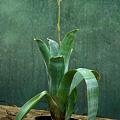Q: Brocchinia: the nicky dicky plant
A: Brocchinia is a genus of bromeliads which includes at least
two species which are probably carnivorous.
How are they carnivorous? In nature (but rarely in cultivation), the leaves form a tightly bound, erect column that looks like an organ pipe.
And just like an organ pipe the center of the column is hollow. Unlike an organ pipe, it is filled with water and the decaying remains of
insects that fell into the tube. Here, apparently, we have a simple pitfall pitcher plant.
There are a few refinements on this basic model---there are always refinements. In this case, the leaves are coated with a slippery,
waxy cuticle that presumably makes for a more slippery surface. Stew McPherson claims that the water in the urn is often
perfumed, which is quite interesting.
The two species most frequently cited as being likely carnivores differ slightly in structure, and this might suggest differences in
trapping strategy.
Many questions remain unanswered. Is the water in the urn produced by the plant or
by rainwater? Does the plant produce its own enzymes? Probably not; probably the digestion is performed by
commensal organisms. So is this plant really carnivorous? Does it absorb the nutrients? If we consider
Brocchinia (and the bromeliad Catopsis berteroniana)
to be carnivorous, does that open the door for redefining another bazillion bromeliad species as carnivorous?
Would that be bad?
Many insects live inside the urns of Brocchinia, including larva that survive despite the possibly
digestive
nature of the fluid.
Interestingly, species of the carnivorous plant genus Utricularia have also discovered this fact,
and have evolved long, arcing tendrils that reach up into the air and then descend into the
water-filled central urns and leaf axils of Brocchinia and other bromeliads. Once these tendrils
find the pockets of water in the bromeliads, they branch and grow into separate plants that feast upon the denizens
therein. Life is so interesting!
The genus name Brocchinia honors the Italian botanist Giovanni Battista Brocchi (1772-1826).
As far as I know, there are no "common names" for Brocchinia. So to sate those silly
people who insist on using only common names, I present to you a name of my own coining: the nicky dicky plant. It is about as
useful as most common names, in my opinion.
Page citations: Juniper, B.E., et al. 1989; Mabberley, D.J. 1987;
McPherson, S. 2006; Rice, B.A. 2006a; Studnicka, M. 2003b; personal observations.

